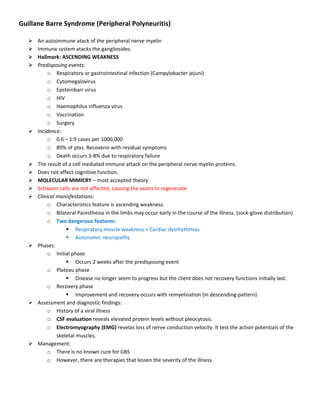
Guillane barre syndrome
- 1. Guillane Barre Syndrome (Peripheral Polyneuritis) An autoimmune atack of the peripheral nerve myelin Immune system atacks the gangliosides. Hallmark: ASCENDING WEAKNESS Predisposing events: o Respiratory or gastrointestinal infection (Campylobacter jejuni) o Cytomegalovirus o Epsteinbarr virus o HIV o Haemophilus influenza virus o Vaccination o Surgery Incidence: o 0.6 – 1.9 cases per 1000,000 o 89% of ptxs. Recoverin with residual symptoms o Death occurs 3-8% due to respiratory failure The result of a cell mediated immune attack on the peripheral nerve myelin proteins. Does not affect cognitive function. MOLECULAR MIMICRY – most accepted theory Schwann cells are not affected, causing the axons to regenerate. Clinical manisfestations: o Characteristics feature is ascending weakness. o Bilateral Paresthesia in the limbs may occur early in the course of the illness. (sock-glove distribution) o Two dangerous features: Respiratory muscle weakness + Cardiac dysrhythmias Autonomic neuropathy Phases: o Initial phase Occurs 2 weeks after the predisposing event o Plateau phase Disease no longer seem to progress but the client does not recovery functions initially last. o Recovery phase Improvement and recovery occurs with remyelination (in descending pattern) Assessment and diagnostic findings: o History of a viral illness o CSF evaluation reveals elevated protein levels without pleocytosis. o Electromyography (EMG) revelas loss of nerve conduction velocity. It test the action potentials of the skeletal muscles. Management: o There is no known cure for GBS o However, there are therapies that lessen the severity of the illness.
- 2. Medical mgt: o Problems: Immobility Incontinence (stool and urine Abdominal distention Respiratory failure - therapy or mechanical ventilation Dysrhythmias o Plasmapheresis Also known as therapeutic plasma exchange To remove plasma proteins containing antibodies Just like hemodialysis o Intravenous immunoglobulin G (IV IG) Prevention of Complications o Anitcoagulant therapy o Thigh-high elastic compression stockings of sequential compression boots o ECG monitoring o Management of tachycardia and hypertension Prognosis o Usually good 75% o Recovery may take weeks to months o DTR are last to recover Nursing interventions o Maintaining respiratory function Incentive spirometry and chest physiotherapy Suctioning as needed Mechanical ventilation may be required o Enhancing physical mobility Support paralyzed extremity in functional position Passive range of motion exercises at least twice daily Prevent DVT and pulmonary embolism • ROM exercises • Thigh high elastic compression stockings or sequential compression boots • Adequate hydration Prevention of pressure ulcers • Padding over bony prominences • Consistent position changes every 2 hours • Evaluation of laboratory test results that may indicate malnutrition or dehydration Provide adequate nutrition • IV fluids and parenteral nutrition as prescribed • Gastrostomy tube may be placed to administer nutrients • Assess the return of the gag reflex and bowel sounds before resuming oral nutrition Improving communication • Establish some form of communication with picture cards or an eyeblink system Decreasing fear and anxiety
- 3. • Diversional activities • Encourage visitors Monitoring potential complications • Assessment of respiratory function at regular intervals o Signs and symptoms of impeding respiratory failure: Breathlessness while speaking Shallow and irregular breathing Use of acceory muscles Tachycardia Changes in respiration function o If there is relapse, GB is worsening - Aggressive treatment should be done like plasmapheresis and IV IG. o Watch for progressive muscle weakness. o Checking for increasing mobility o IV IG contains healthy antibodies, as treatment for GBS, contain high doses of immunoglobulin Should not be used more than 5 days if so, it will result to renal failure and hepatitis o Plasmapheresis